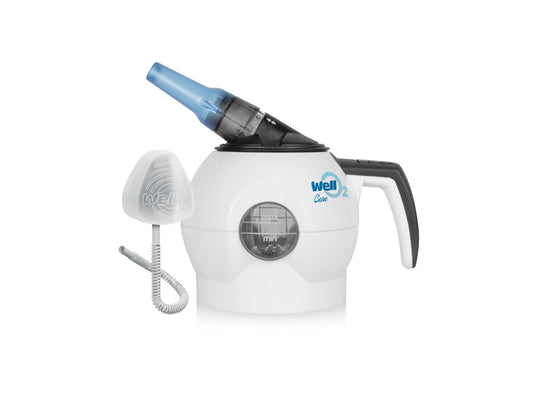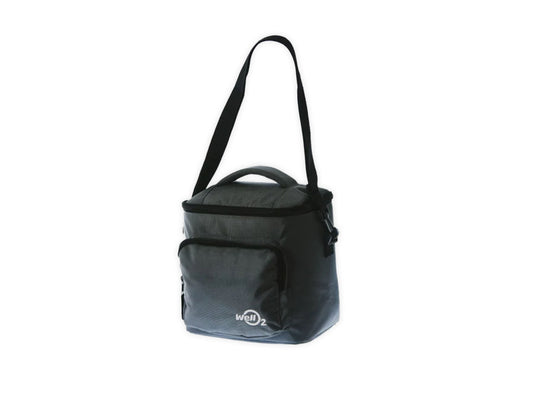
WellO2 Breathing Training
Guides for WellO2 breathing training for everyday use and for athletes
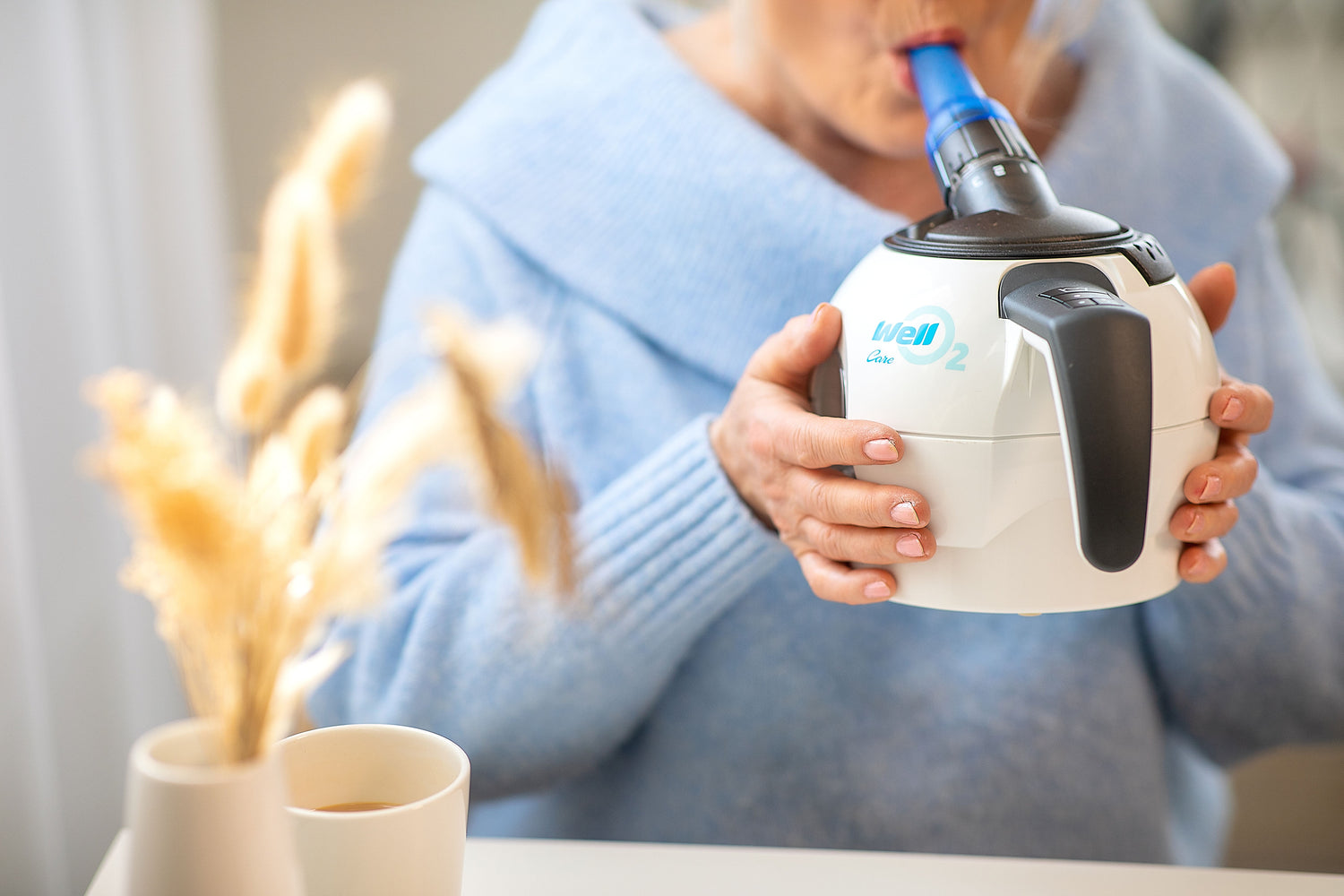
WellO2 breathing training is beneficial for everyone
Studies have shown that respiratory muscle exercise (RMT):
- Increases inspiratory and expiratory airflow and blood circulation
- Builds inhalation and exhalation strength
- Lowers stress & improves general well-being
- Helps to adopt deep breathing techniques for wellbeing
WellO2 Breathing Exercises Guide
-
-
Why Use WellO2?
-
Clear lungs & respiratory tract
WellO2 steam breathing reduces respiratory irritation & cleanses lungs by encouraging removal of mucus, pollen, dust & air pollutants.
-
Improve breathing
Helps immediately open the airways.
-
Safe & easy to use
WellO2 training is easy, safe regardless of age and starting condition.
-
Improve strength & endurance
WellO2 strengthens respiratory muscles & improves breathing endurance for better performance & faster recovery.
-
Support Your Breathing in 5 Easy Steps
-
1. Exhale
Blow calmly into the device.
-
2. Inhale
Breathe in the warm, soothing steam from your WellO2 device.
-
3. Repeat
Repeat 3 to 10 times, you can rest between repetitions.
-
4. Use mask
Open the upper respiratory tract and reduce congestion with the help of the nasal mask.
-
5. Practise
Use WellO2 for just a few minutes a day for optimal results.
WellO2 Breathing Training for Daily Use
-
In normal use, always start training at the lowest resistance (position 0). When the device is ready for use (see user manual), begin the exercise by inhaling air fully and exhaling steadily and calmly into the device (over 10–15 seconds).
Afterwards, breathe freely for a few times, and repeat the exhale as before. Repeat these exercises several times (3–10). Perform a similar exercise, but this time, inhale steadily from the device, filling your lungs fully (over approximately 10–15 seconds). Rest between repetitions as you did before.
Once you're accustomed, you can do exercises where you alternate breathing into and out of the device. Immediately after exhaling (for 10–15 seconds), inhale air (for 10–15 seconds) from the device. You can repeat these exhale and inhale cycles according to your comfort.
In normal use, we recommend aiming for 10–20 repetitions, which don't need to be done all at once but can be spread over multiple sessions. Remember, while the exercise may be strenuous, it shouldn't cause pain or dizziness. If you experience pain during exercise, stop using the device and contact the manufacturer. If you feel dizzy during the exercise, rest longer between repetitions.
WellO2 Breathing Training for Athletes
-
WellO2 can be used for adding breathing muscle power and endurance. In the same time, it promotes general respiratory health by moisturizing airways. Adding maximal breathing power takes high breathing resistance and less ex- and inhaling repetitions whereas endurance training requires lower breathing resistance and multiple repetitions.
It’s also good to remember that using higher breathing resistances can only be done when your airways are apparently healthy i.e. no prevailing infections or severe respiratory diseases. Intensive breathing exercise causes stress to breathing organs which should be taken into consideration especially during competition season. Therefore, we recommend that intensive breathing exercise is done outside competition season.
Adding maximal breathing power
GOAL: Adding maximal exhaling and inhaling power
SETTINGS: Breathing resistance should be app. 60% from the maximal breathing power. If your maximal breathing power is 200 H2Ocm, you should use app. 120 H2Ocm resistance which equalises setting 2 in WellO2 device. Inhaling resistance is therefore 2/3 from the exhaling resistance i.e. 80 H2Ocm. Keep the water temp. to mild or medium mild.
Because maximal breathing resistance can not be approximated without measurement, you can choose the settings from the info below:
o Maximal exhaling power of the normal adult is 140 – 160 H2Ocm
o Maximal inhaling power of the normal adult is 80 – 120 H2Ocm
o Maximal exhaling power of the trained user is 180 – 220 H2Ocm
o Maximal inhaling power of the trained user is 120 – 160 H2Ocm
In these cases, correct setting for the normal adult is 2 (84-96 H2Ocm), and for the trained person 3 (108-132 H2Ocm).
EXERCISE: The exercise is performed by repeating ex- and inhales with the device for 3-5 times (one set). In- and exhaling time should be app 6-10 second. Rest app. one minute in between the sets. Perform app. 5 - 7 sets.
PLEASE NOTE: The exercise is done only once a day and 3-5 times a week. After a few weeks you should have at least a week's break from the exercise. The increase in the maximum power is usually seen in measurements only after two weeks of training, depending on the baseline. This exercise is not recommended during the week preceding the competition.
Endurance training
GOAL: The aim is to increase the endurance of the respiratory muscles through longer repeats and lower resistances.
SETTINGS: As above, but now the resistance is set to about 30% of the maximum breathing power. For normal people this is about 40 H2Ocm when exhaled and 25-30 H2Ocm when inhaled. The setting is then 0-1.
The corresponding values for the trained persons are 50 to 60 H2Ocm and the setting 1-2.
EXERCISE: The exercise is performed by repeating ex- and inhales with the device for 5-7 times (one set). In- and exhaling time should be app 10-15 second. Rest app. one minute in between the sets. Perform app. 10 - 15 sets.
PLEASE NOTE: Exercise is done only once a day and 2-3 times a week. After a few weeks you should have at least a week's break from the exercise. This exercise is not recommended during the week preceding the competition.
How WellO2 Works?
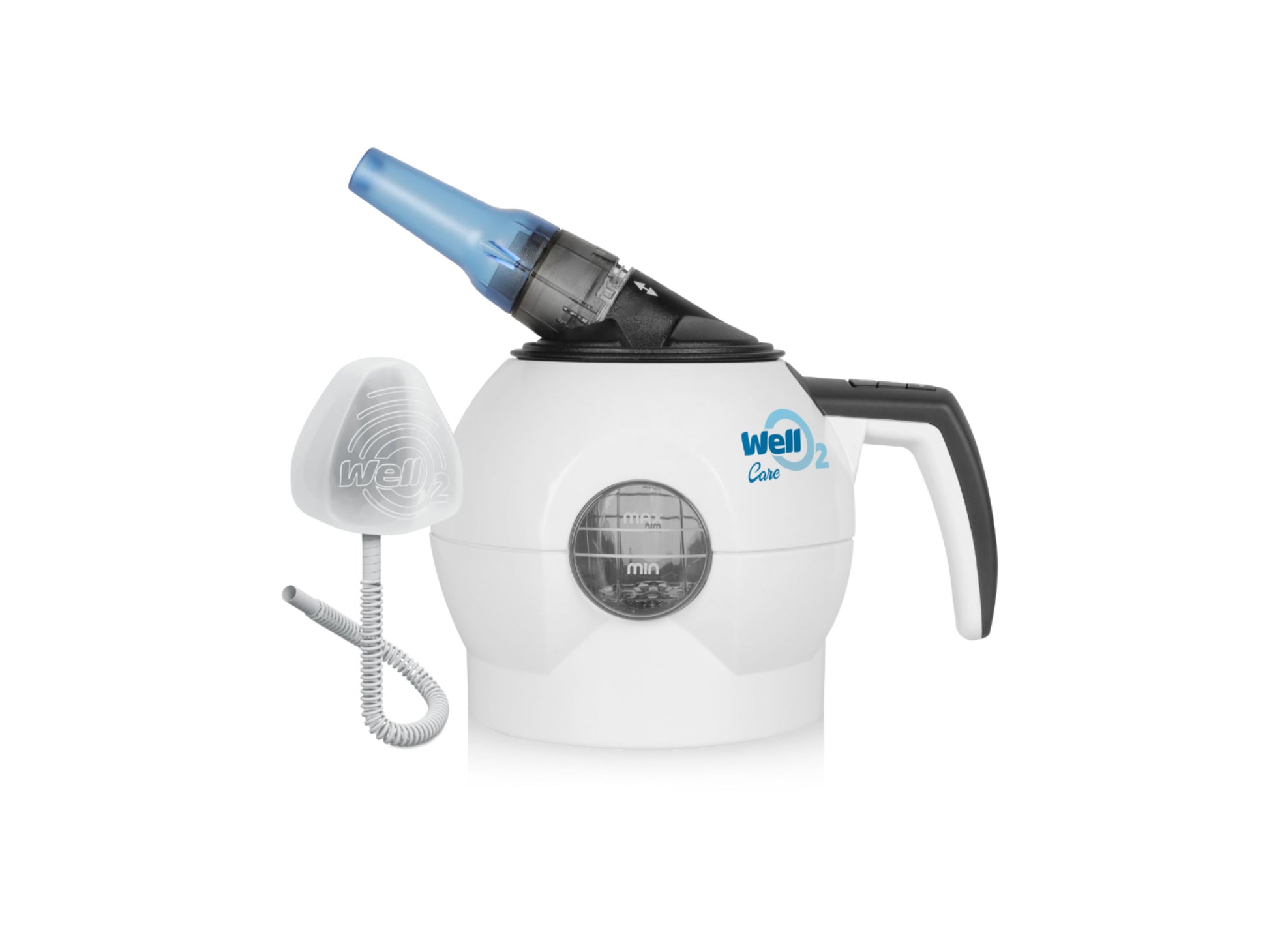
WellO2
4.425925925 /
(54) 54 total reviews
Free shipping
Delivery 1-4 days
Share
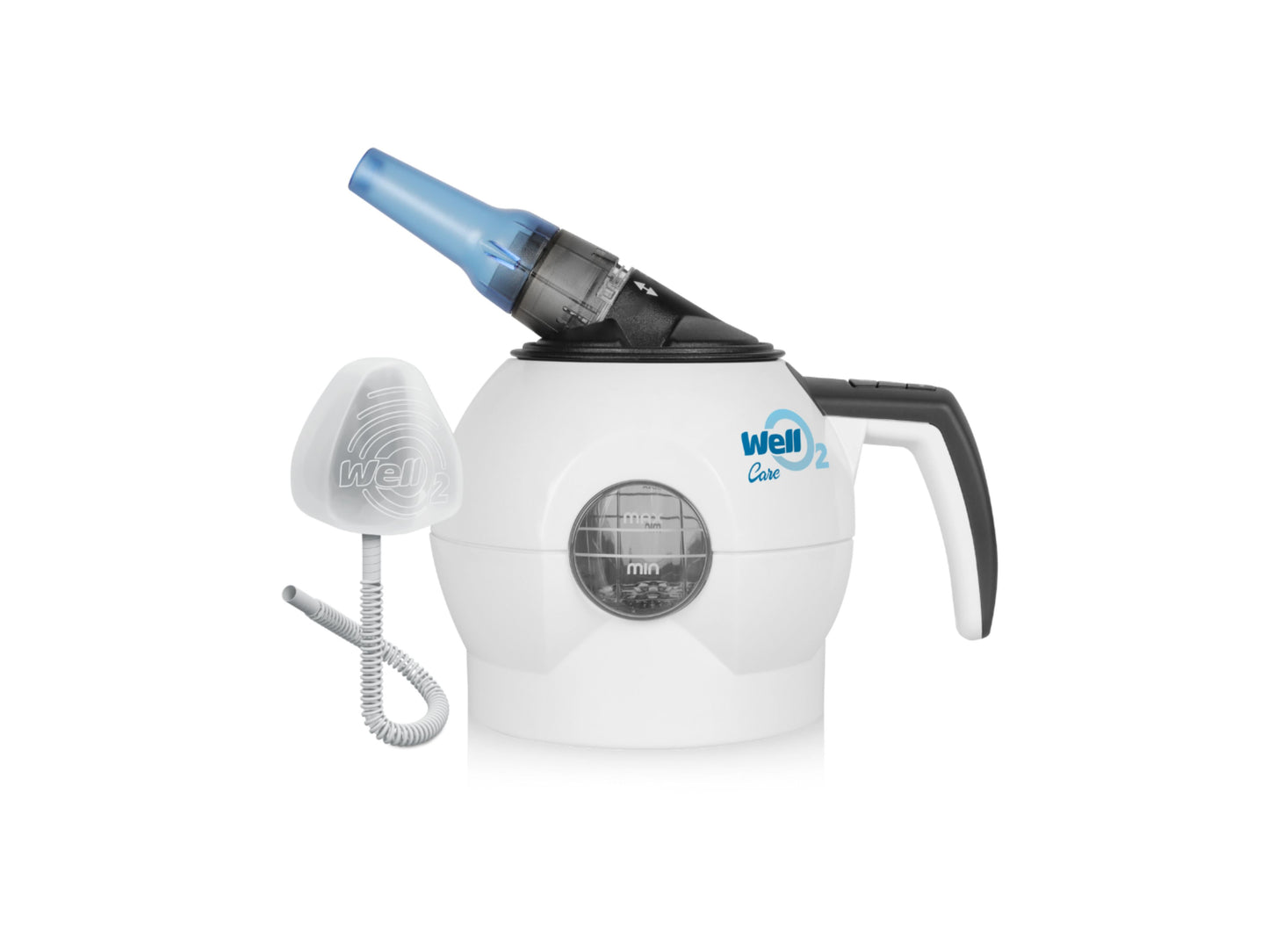
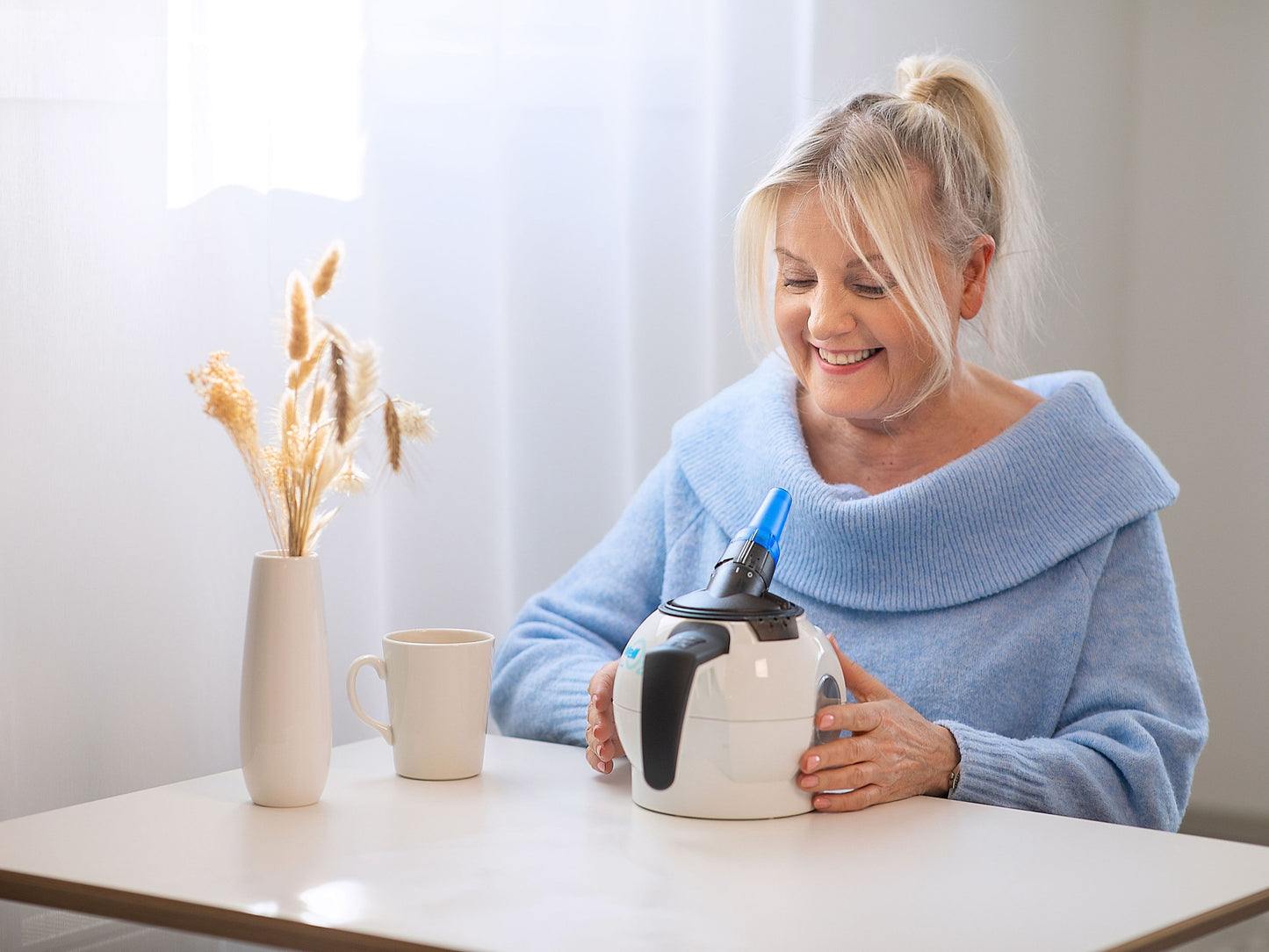
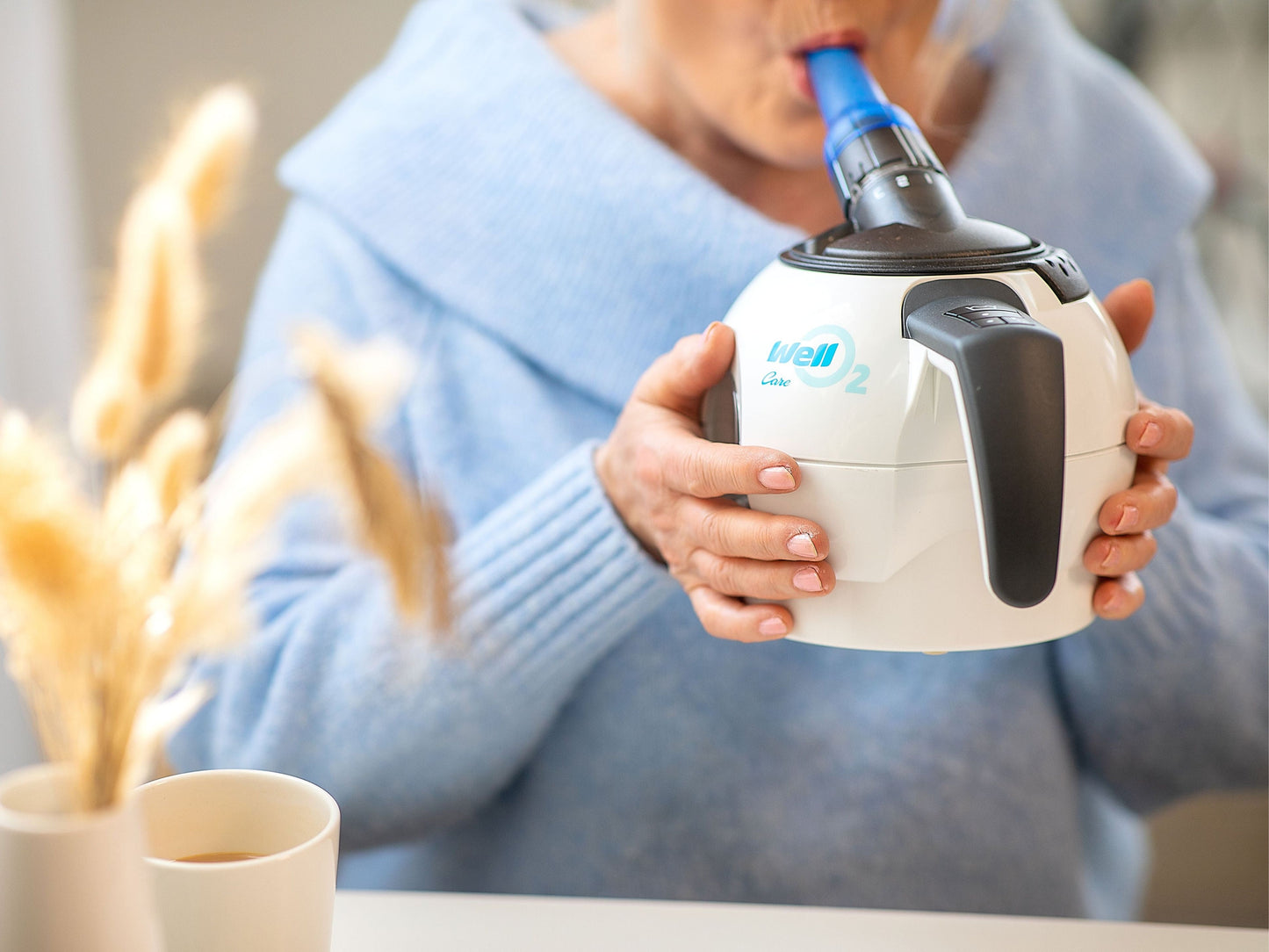
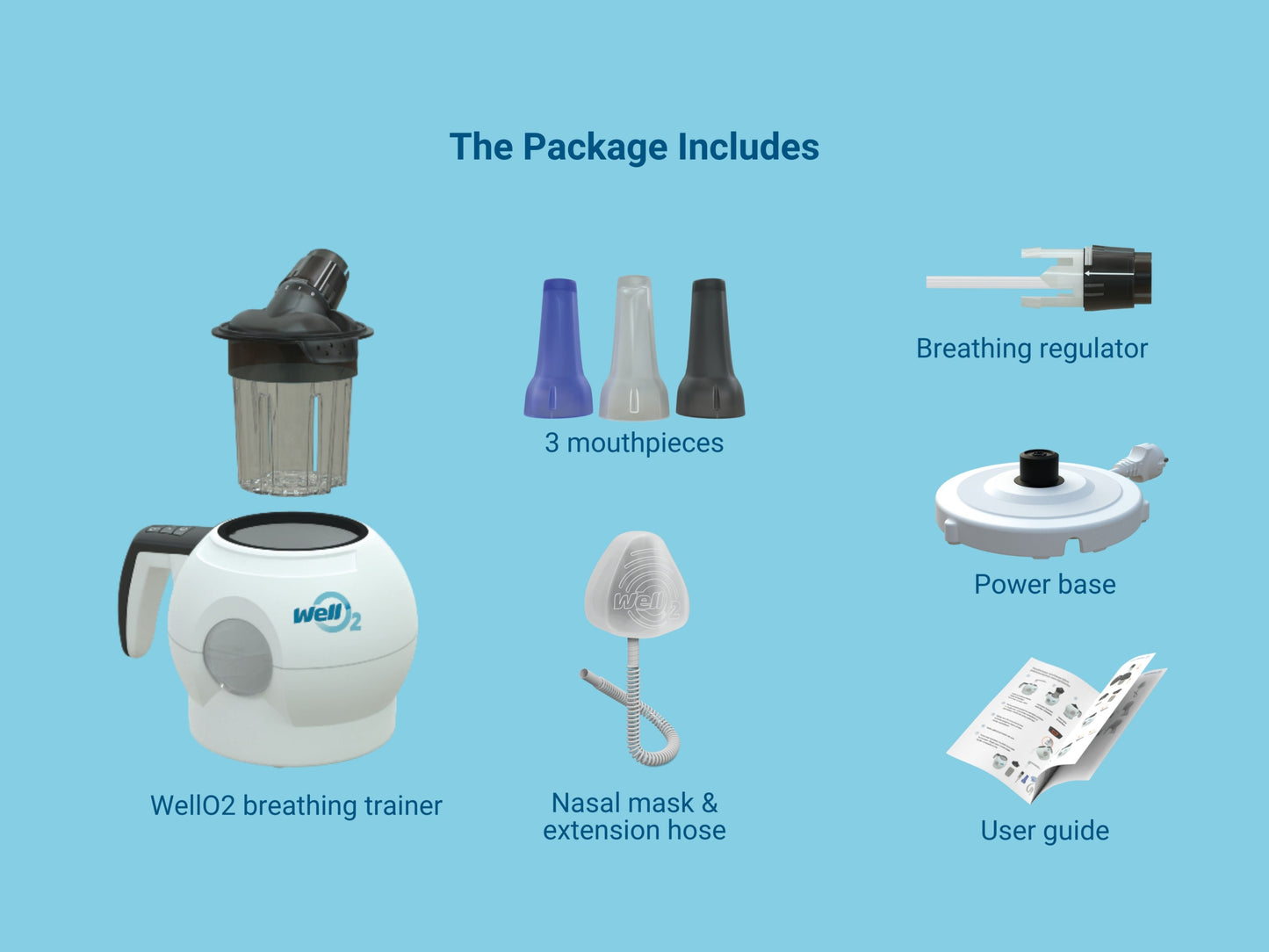
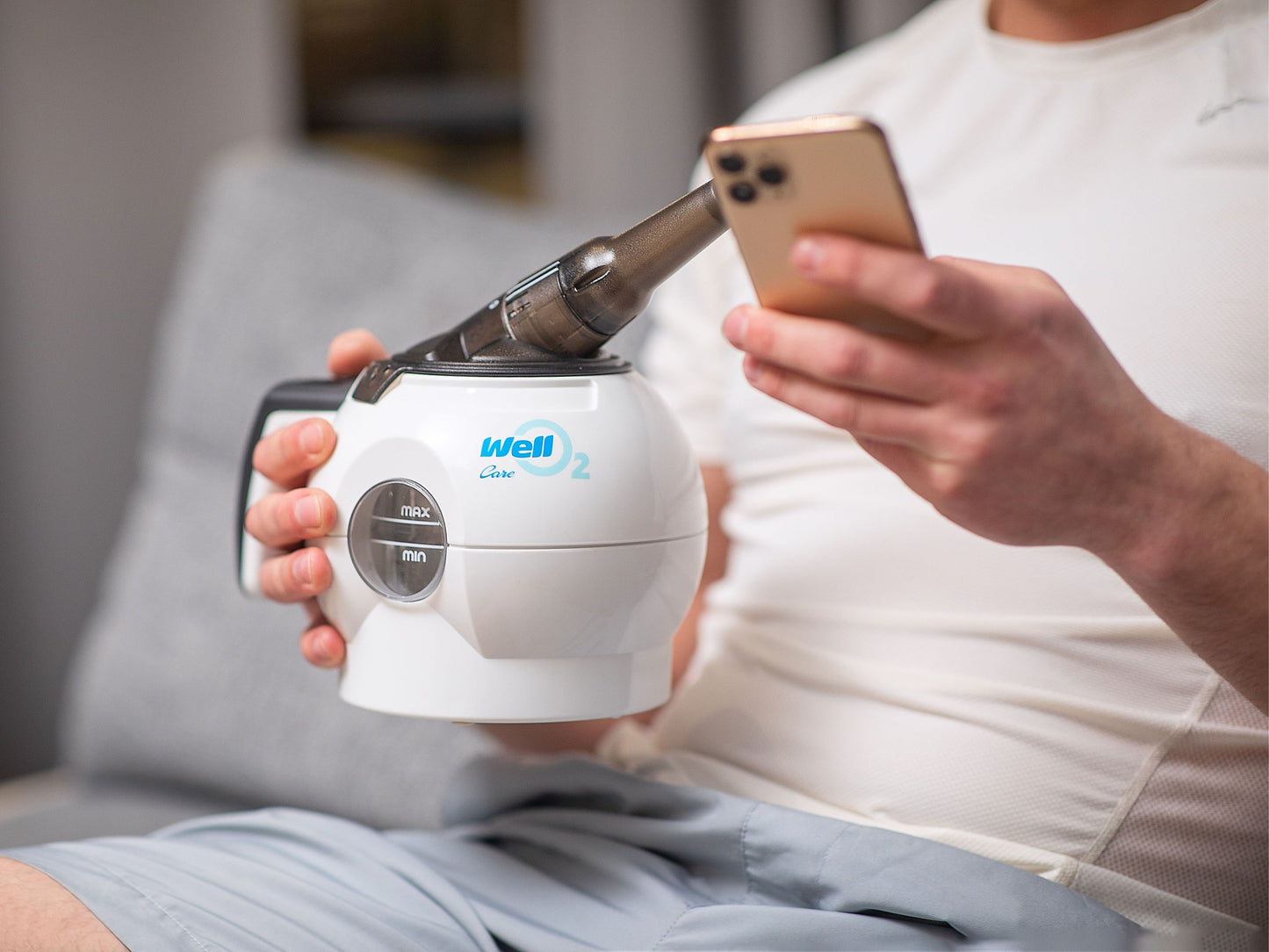
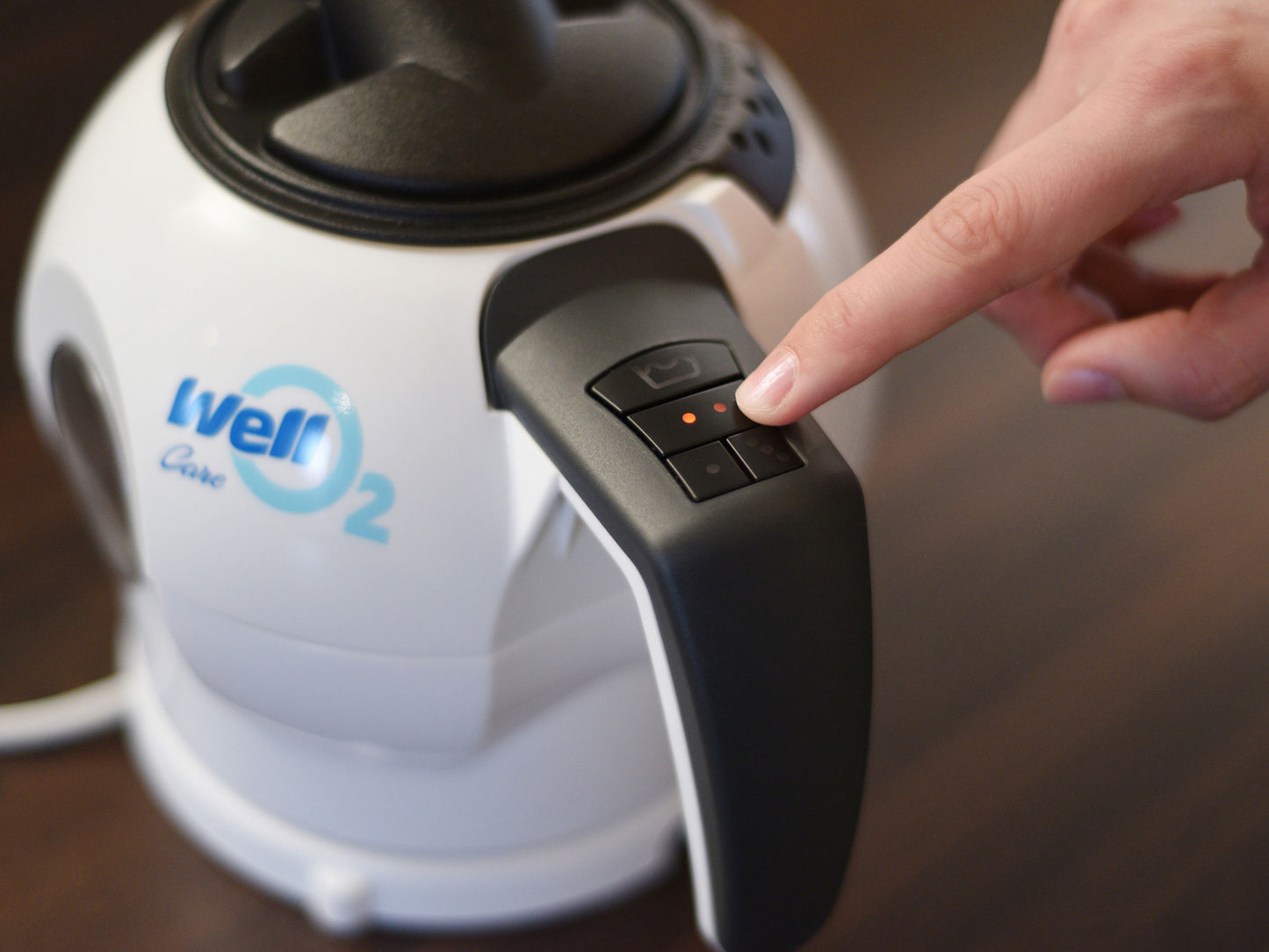
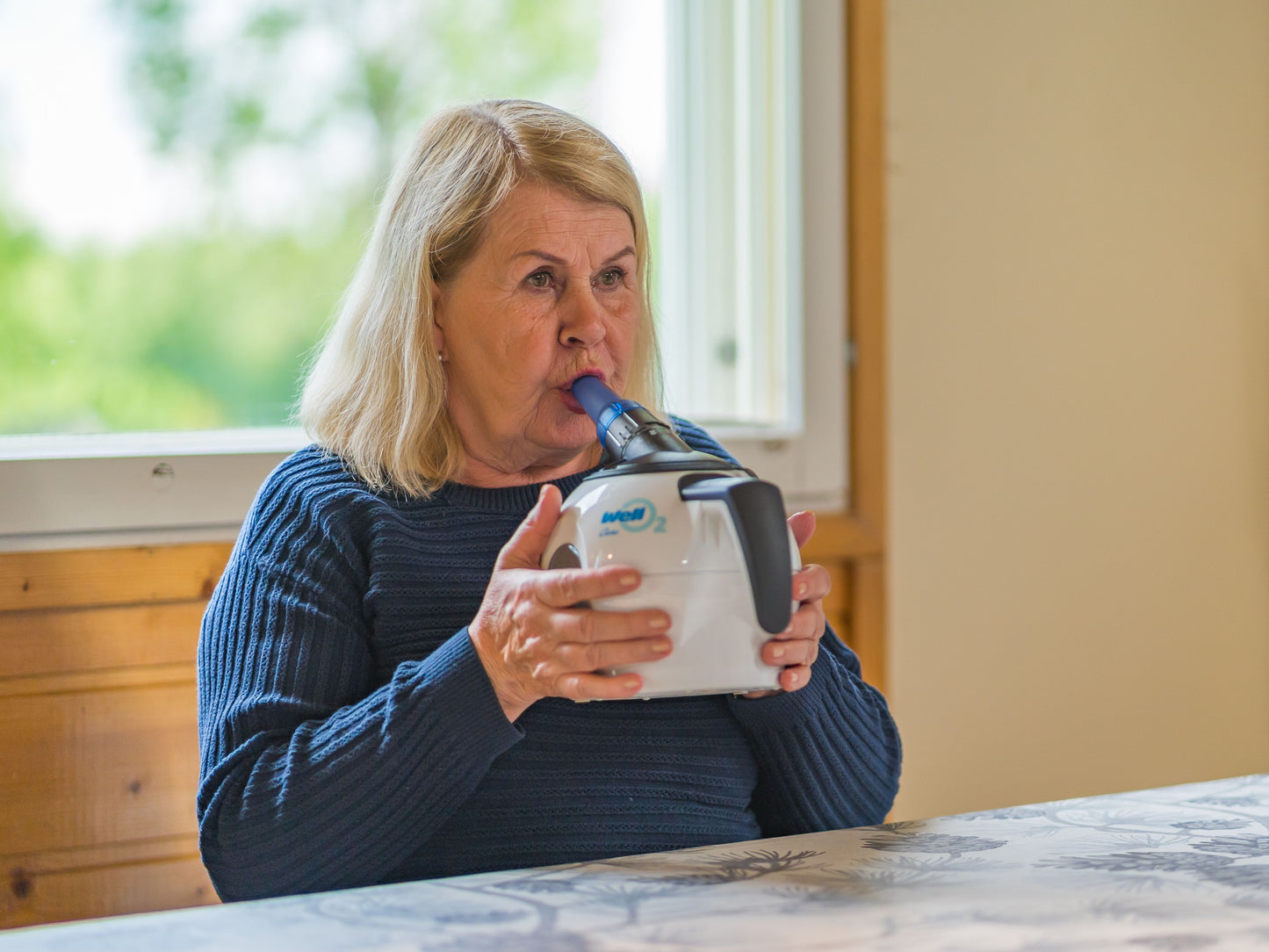
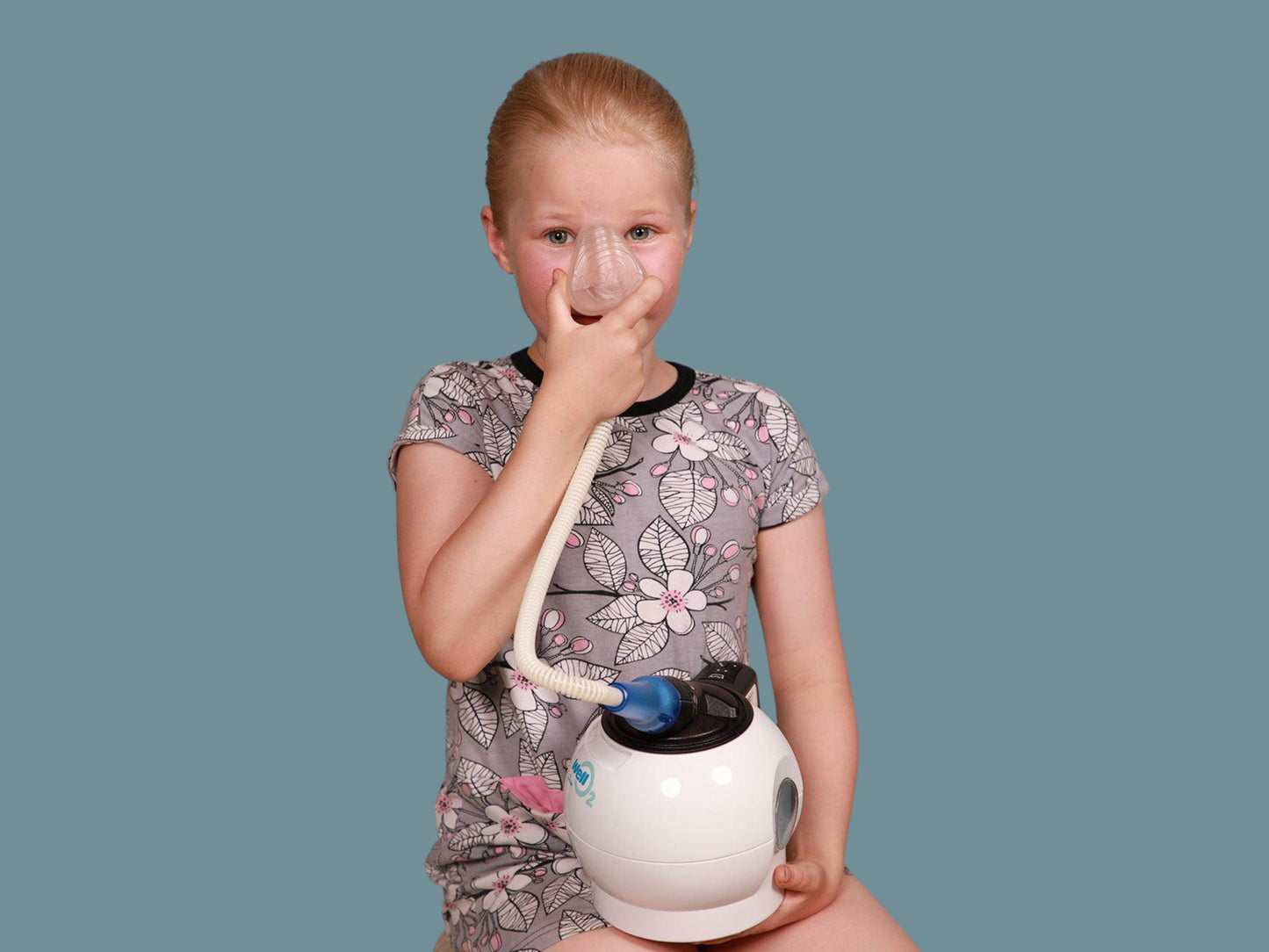
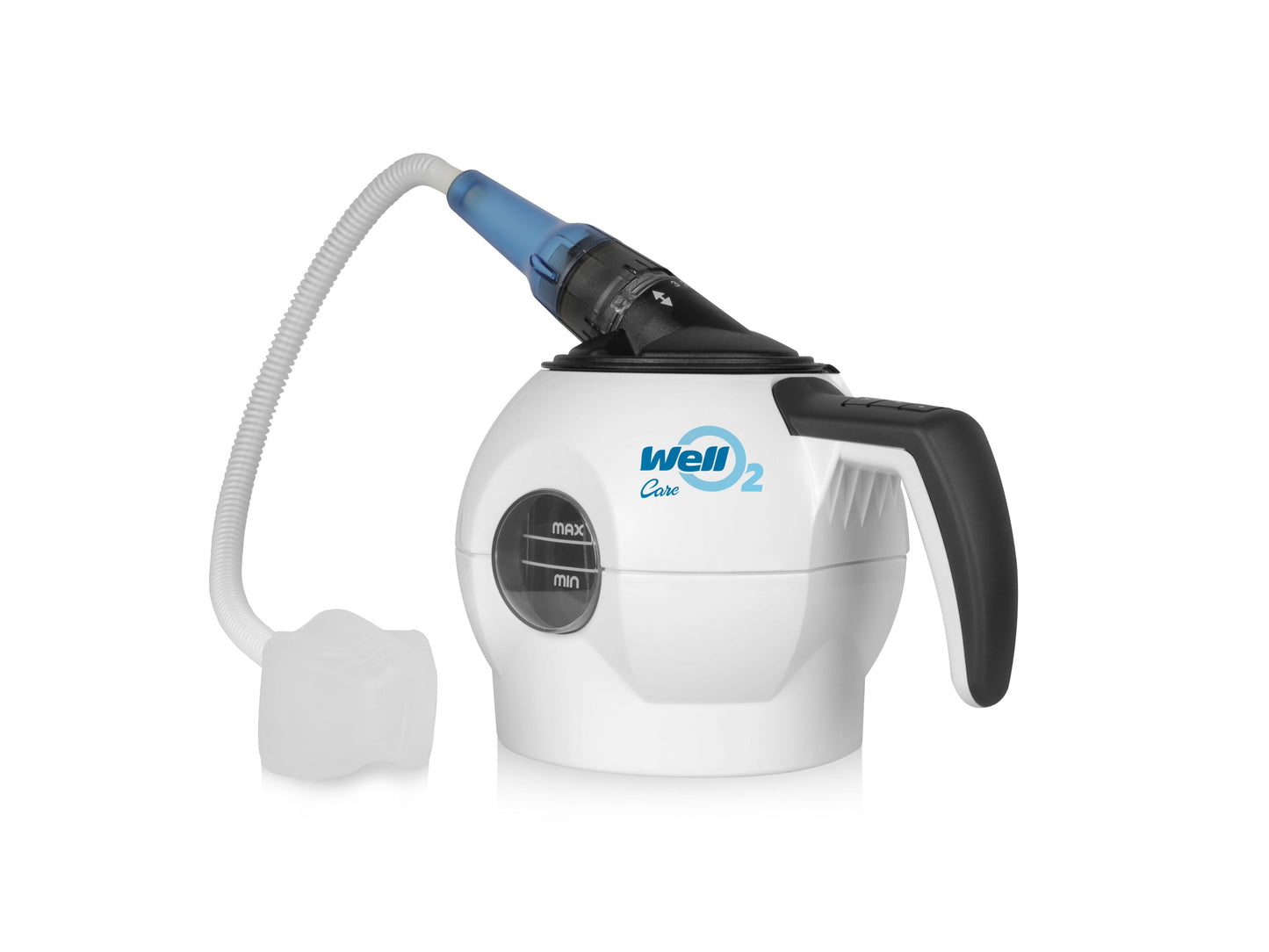
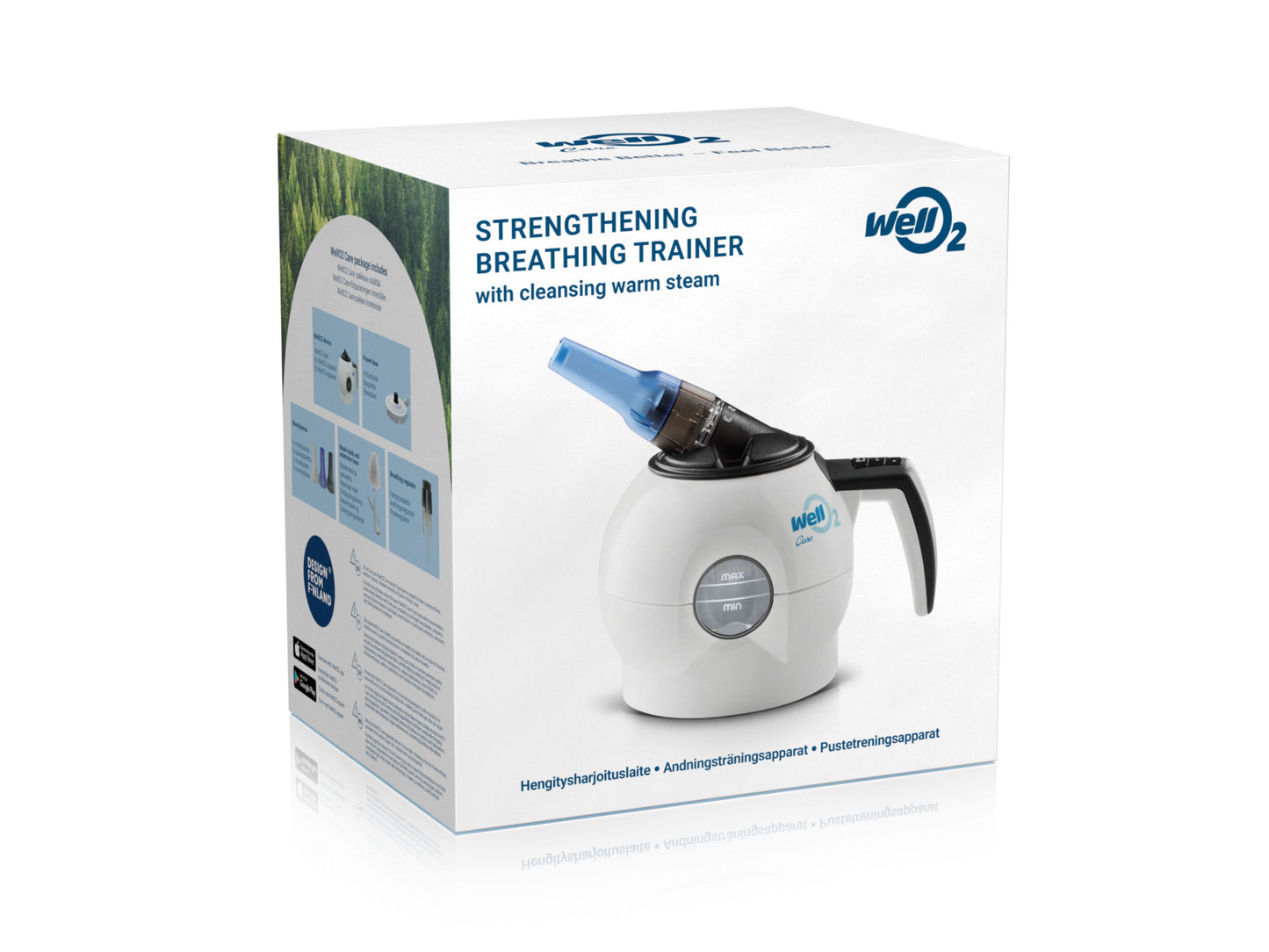
Shop Products
-
WellO2
4.425925925 /
(54) 54 total reviews
Regular price €249,00 EURRegular price- Unit price
- / per
-
WellO2 Carrying bag
Regular price €44,90 EURRegular price- Unit price
- / per
Real people. Real results.
I regularly inhale warm steam, including to the upper respiratory tract with the help of the nasal mask that comes with the device. This is especially important during the flu season when the risk of getting sick is higher. I have managed to stay exceptionally healthy for the last three training seasons. Using Wello has been one of my key preventative ways to avoid getting sick.
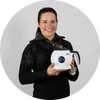
KRISTA PÄRMÄKOSKI
Finnish National Team Cross-Country Skier
I now take my WellO2 device with me everywhere in the world. I’ve had it for about a year. No matter the temperature or humidity – if my voice feels a bit dry or rough, just a few minutes with this device, and I’m singing like a Vienna Boys' Choir member.

BERNIE SHAW
Professional Singer, Uriah Heep
I was surprised by how pleasant it felt to breathe with the WellO2 device. The nasal mask, in particular, was very helpful. I find the device easy and comfortable to use.
While running, I noticed how much easier breathing felt. The improvement in oxygen intake becomes evident when you don’t get out of breath as quickly.
I would recommend the WellO2 device to anyone who breathes, but especially to those who experience respiratory issues or frequently get sick. It’s also great for families with children!
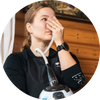
HEIDI S
After a few months of WellO2 training, my breathing strength and capacity improved by about 20%, reaching the same level as a healthy, athletic 30-year-old Jari before developing asthma at work. I am forever grateful to WellO2.
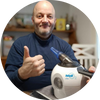
JARI A
I have noticed that my breathing has overall become stronger and clearer with the use of WellO2. I use it at least twice a day, in the morning and evening. WellO2 not only exercises the lungs but also all the other muscles needed for voice production, including the side and abdominal muscles. Considering the good results, the time investment is not very much. I always have it with me on tours.

MARKO HIETALA
Professional Singer
I've slept better since I started using the device, and I also feel more refreshed. I used to be ashamed to constantly clear my throat around people, but now I feel relieved. It’s a good device, I certainly give it a ten out of ten. Good and easy!

ANJA V
I bought my WellO2 and I noticed a significant improvement in my breathing after the very first use. Back when I was a professional athlete, I even took my WellO2 with me on competition trips.
In my opinion, WellO2 is suitable for everyone. It helps your body relax in the evenings, and most importantly, it’s great for easing symptoms when a cold strikes, reducing the severity of aftereffects compared to not using WellO2.
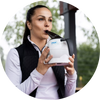
MARIA HUNTINGTON
Former Track and Field Heptathlete
Using the nasal mask that comes with the device in the evening clears my nose completely, making it much easier to go to sleep. Since starting with WellO2, I haven’t needed to use nasal drops anymore.
WellO2 training has greatly helped my instrument playing. It has opened up my airways, relaxed my muscles, and activated my intercostal muscles. Additionally, it has made my breathing deeper, which allows for a more relaxed and resonant sound from my instrument.

MIKKO M
Trombone and Tuba Player
I have used the WellO2 device for several purposes. I have mild sleep apnea, and I also use it for general relaxation, which it has been very effective for. My sleep quality has improved. I can calm down a bit better before bed, sleep a little deeper, and simply feel more refreshed in the morning.
It seems that the breathing exercises have brought small but noticeable benefits quite quickly. During dry indoor air conditions, the device has also helped moisturize my airways and improved the condition of my mucous membranes.

OSKARI V
WellO2 has been a valuable addition to our performance toolkit. The WellO2 breathing device has become a go-to adjunct for players with minor respiratory issues, helping clear airways and supporting their recovery.
During the winter months, we’ll be using the WellO2 devices to aid players that raise concerns through respiratory illness.
We’ve enjoyed our relationship with WellO2 so far since the start of the partnership and we look forward to working closely with their team to explore how their recently launched smart mouthpiece can help us track data metrics and monitor players’ breathing on a regular basis.

Richard Collinge
Director of Performance, West Ham United
We have been in interaction with WellO2 since 2017 when they first produced us the idea of using WellO2 device. Our members have been able to buy the device with a special price and we have gotten very good feedback from them, that the method really works and helps them to breathe easier.
Our commercial cooperation started around 2020 when we granted the right to use our logo in advertising WellO2. During the years the company has succeeded in producing scientific results of the effectiveness of the device.
We are confident of the product and hope, that this invention will in the future help also people with respiratory diseases outside Finland to breathe easier. We are the member of EFA – European Federation of Allergy and Airways Diseases Patients’ Associations
The Organisation for Respiratory Health in Finland is an advocate for respiratory health. Our mission is to promote respiratory health and a good life for the respiratory disorder to make it easier for all of us to breathe.

MERVI PUOLANNE
Organization Manager
The Organisation for Respiratory Health in Finland
- Choosing a selection results in a full page refresh.
- Opens in a new window.
